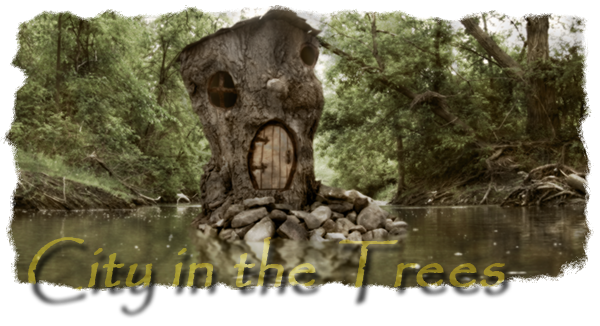Last week, I happened to check one of those sites on a hunch. Sure enough, it turned out I had the wrong route. It wasn't the QEW. It was Highway 5... Dundas Street, over Twelve Mile Creek (a.k.a. Bronte Creek).
P-Doug came along with me on Saturday morning to check it out. An interesting walk was in the offing as well. Heading north, Burloak Drive (initially on the border between Burlington and Oakville, hence the name) is, as I remembered, closed for a chunk that makes it useless for cars trying to get between Dundas Street and Upper Middle Road, but I figured it should be just the ticket for hikers. To my surprise, when we arrived at the intersection of Burloak Drive and Upper Middle Road, we discovered Burloak had been permanently closed, and very recently. It looked like we wouldn't be dodging much traffic as we walked.
On the right, as we headed north, was the very sharp drop down to Twelve Mile Creek. On our left, through a very narrow line of trees, were the monster homes that have been being built there since around 1990. Oddly enough, about half way to Dundas, we came to a stretch of Burloak Drive that was still open! They had had to build a new access to it from the western subdivision, but it had to be done because a score or so homes still front onto Burloak itself, and those people needed access they couldn't get otherwise now that the road is closed at Upper Middle Road. A couple of minutes' walk through that small, privileged knot of homes and we came to the start of the ancient road closure, the one I had actually anticipated, that has been closed since at least some time in the 80s. There, the road closed in a little to become more of a trail; the decades had seen the course's partial return to nature. Beyond that, it opened up again, to a wider path that represents what was, till recently, the other open end of the road, now itself closed off all the way to Dundas Street. This section I can remember, barely, driving to explore way back around 1990, just to see where it went (nowhere, really).
This brought us to Dundas Street, Highway 5. Not a 400 series highway, but aside from the traffic lights, people pretty much treat it as one. It's on the verge of the countryside in Burlington, but even in Oakville, I've seen the city creep up to it, and then close in around it. What was countryside when I got my license 20 years ago is now the "new" upper fringe of suburban Oakville. Where we were in Burlington, it represented the northern limit... for the moment.
Traffic hurtled along Dundas Street as we made our way out on the sidewalk on the southern side. There, below us, were the pillars that once carried the traffic across the valley, dwarfed by the bridge on which we stood, but their very height and existence underlining just how high up we actually stood above the valley floor. I knew from my reading that those lonely supports carried a bridge was actually the third of four (the fourth being the current on) going back well over a century, I imagine. The third was built in 1921. P-Doug's investigation revealed that the cost of that bridge, back then, was just shy of an astounding $76,000. It's hard to imagine building something like that for less than seven figures, even in the 1920s; the current bridge must be worth tens, maybe hundreds of millions of dollars for all I know. While not as high or long as the current bridge (which is level with heights on both sides), and requiring drivers to descend a bit to cross and ascend again on the other side, the 1921 bridge must still have been impressive, especially in its day. Heaven knows what simple span down at the level of the creek it actually replaced; it must have seemed like a wonder of the world, out there at the edge of nowhere, one of the few means across back then. It served until 1948, when it was replaced by the current bridge, which was itself expanded to four lanes in 1979.
To me, the pillars look beautiful, seen in a line, long ago relieved of their burden and retired to the role of forget-me-nots. They remind me of fallen cathedrals at the edge of the water. Millions of people must drive by them every year with no idea they're even there.
On our way back, we wandered into the brush a bit to see if we could get to the little platform that was the western approach to the 1921 bridge, which you can just glimpse from the modern one. There was an overgrown slope, and I was curious enough to make my way down. P-Doug sat this one out, which is ironic because in my experience it tends to be him, rather than me, who will push exploration the extra yard. I got a handful of shots and made a climb back up to Dundas Street (path of least resistence), worrying about the suspicious three-leafed plants coating the place since I was barelegged and, moreover, barefooted since I'd come down the slope. I met P-Doug at the junction of Dundas Street and Burloak Drive, and we retraced the course back south to the car. I never did develop an itchy rash, thankfully.
[Oct. 9, 2008 -- I've since learned that the what you're looking at in the shots below -- the green carpeting, the shoots, the vines clinging to the trees -- is in fact a sea of poison ivy.]
[Sept. 20, 2010 -- Actually, no, now that I look at it again, I'm doubtful it is poison ivy. Poison ivy springs off in alternating sets of three, long middle stem bracketed by shorter ones on either side. This stuff has recurring pairs along the stem with just one odd leaf at the end... I don't think that's poison ivy.]

A thirst was upon us. The map indicated that malls nearby were few and far between, but when we got to Great Lakes Blvd. and Rebecca Street, we were greeted with the sight of a new plaza that featured a place called Wild West, apparently specializing in chicken wings. Right of out the 1880s, the sign said "ICE COLD BEER". Sold. We stopped. We did, indeed, have beer. I had a chicken wrap and the guilty pleasure of fries I shared with P-Doug, and he had cajun wings. The menu there was unlike anything I've ever seen. It must have listed 80, 90, 100 different flavours of wings. And the portions you could order them in ranged from a "single" serving of 10, right up to a "Hillbilly Deluxe" serving of a 1000 — the very definition, I think, of conspicuous consumption. It just begged for a shot.
By the time we left, it was early afternoon, and we were still game to visit a place I'd been before. At P-Doug's suggestion, we had on our agenda trekking to a closed part of Burnhamthorpe Road, bisected and isolated in the 90s by the construction of Hwy 407. It's tricky to get to; the first time I was there, I was really just guessing that a tiny creek shown going under the highway might yield a means. It does: an 8'-wide tunnel that was probably constructed to let wildlife in and out. We parked and made our way beside corn rows to the tunnel, then sloshed along for two minutes to the far side.
Also: in May, I acquired a used Canon PowerShot S70 and sent it to Australia to be reconditioned to shoot infrared images (previously I'd been using a Canon PowerShot G1 for this, but the S70 is of higher quality and yields images more than twice as large). As we set out, I asked P-Doug to man the S70, and from here on in, the black and white images you'll see are infrared images taken by him.
The closed stretch was shorter than I'd remembered it. It must be a trick of the lens; the photos from last time, all I really had to go by, exaggerate the distance by about double. Just after you join the road, there's a section about five feet wide that's been washed out to a depth of about three feet. Oddly enough, there's a large black and orange traffic cone there, to warn off traffic that ought to never arrive (but just might in the form of ATVs). Hornets had made a home in it, unfortunately for P-Doug, who put his hand on it and drew back a finger stung.




 P-Doug, as I said, was wielding the infrared camera. When we arrived at the field at the end of Burnhamthorpe overlooking the creek, we separated for a couple of minutes. He waded into the field where he took these poetic shots of wild grass from the hip. Personally, I think they're the best work the day produced; as I said to him, not merely a record of events, but something iconic.
P-Doug, as I said, was wielding the infrared camera. When we arrived at the field at the end of Burnhamthorpe overlooking the creek, we separated for a couple of minutes. He waded into the field where he took these poetic shots of wild grass from the hip. Personally, I think they're the best work the day produced; as I said to him, not merely a record of events, but something iconic.

 The above four shots show the valley of Sixteen Mile Creek from high above it. The drop off is clifflike, and probably over a hundred feet. It's a beautiful view.
The above four shots show the valley of Sixteen Mile Creek from high above it. The drop off is clifflike, and probably over a hundred feet. It's a beautiful view. You'd have to look closely to see it but there's a living room chair up in this tree. The first time I saw it, last summer, I imagined some teenagers had put it up there as a joke. Later on it occurred to me that it was up there to give a hunter a perch from which to spot, and shoot, deer.
You'd have to look closely to see it but there's a living room chair up in this tree. The first time I saw it, last summer, I imagined some teenagers had put it up there as a joke. Later on it occurred to me that it was up there to give a hunter a perch from which to spot, and shoot, deer.We followed the road along the way I'd gone before to a large, deep arroyo carved into the land. We went a bit beyond it and found ourselves at the far end of the same field along the line we'd come in on; essentially, we'd travelled a semi-circle; a beautiful walk through the forest. On our return, we found a spot in the grass at the edge of the cliff overlooking the creek, and we settled back to sunbathe for an hour an a half before making our way slowly back down the closed road, under the highway, and then back to town.



1 comment:
Great report as always. You need to take along a cartographer so we can see some maps.
Post a Comment